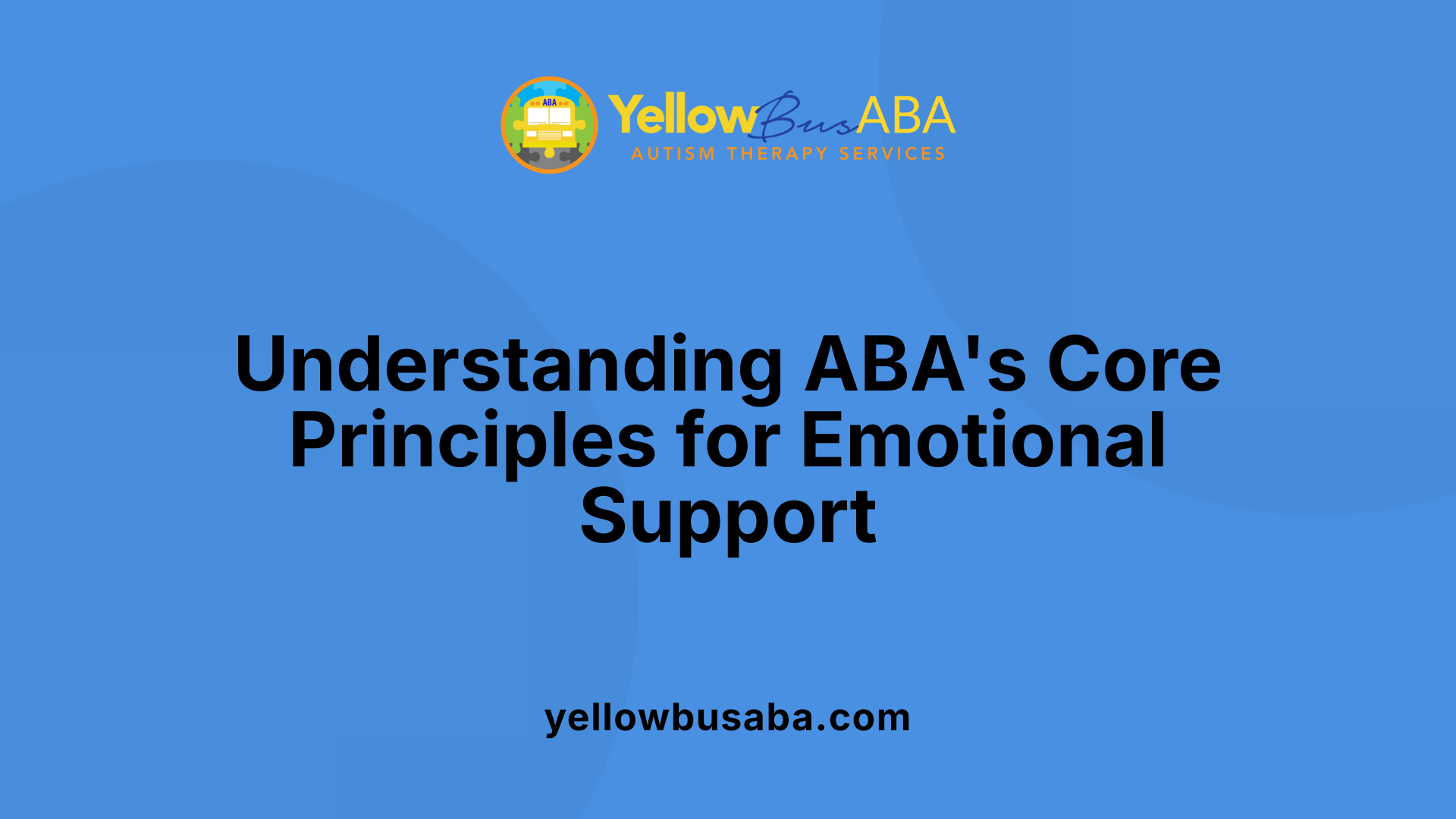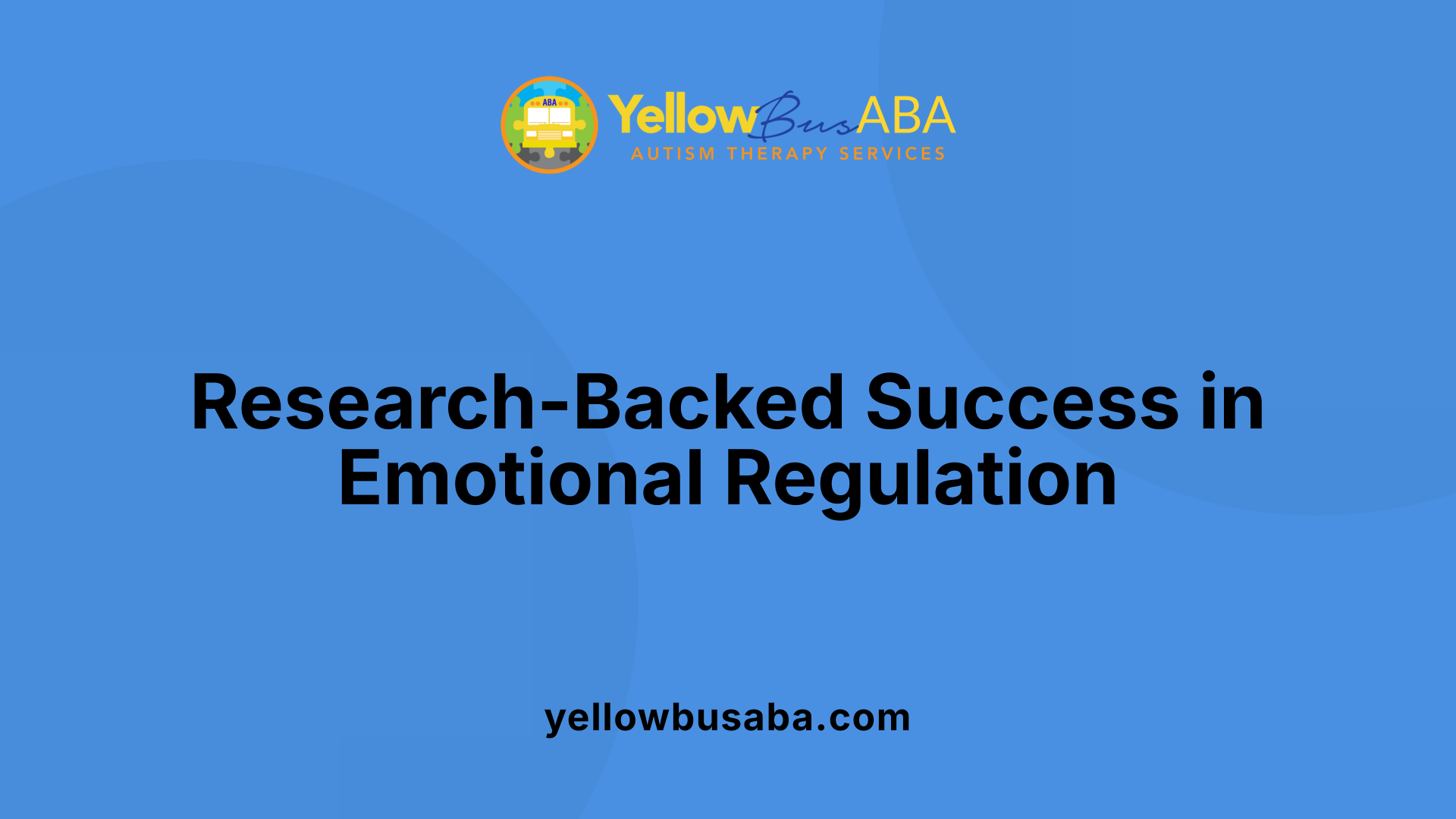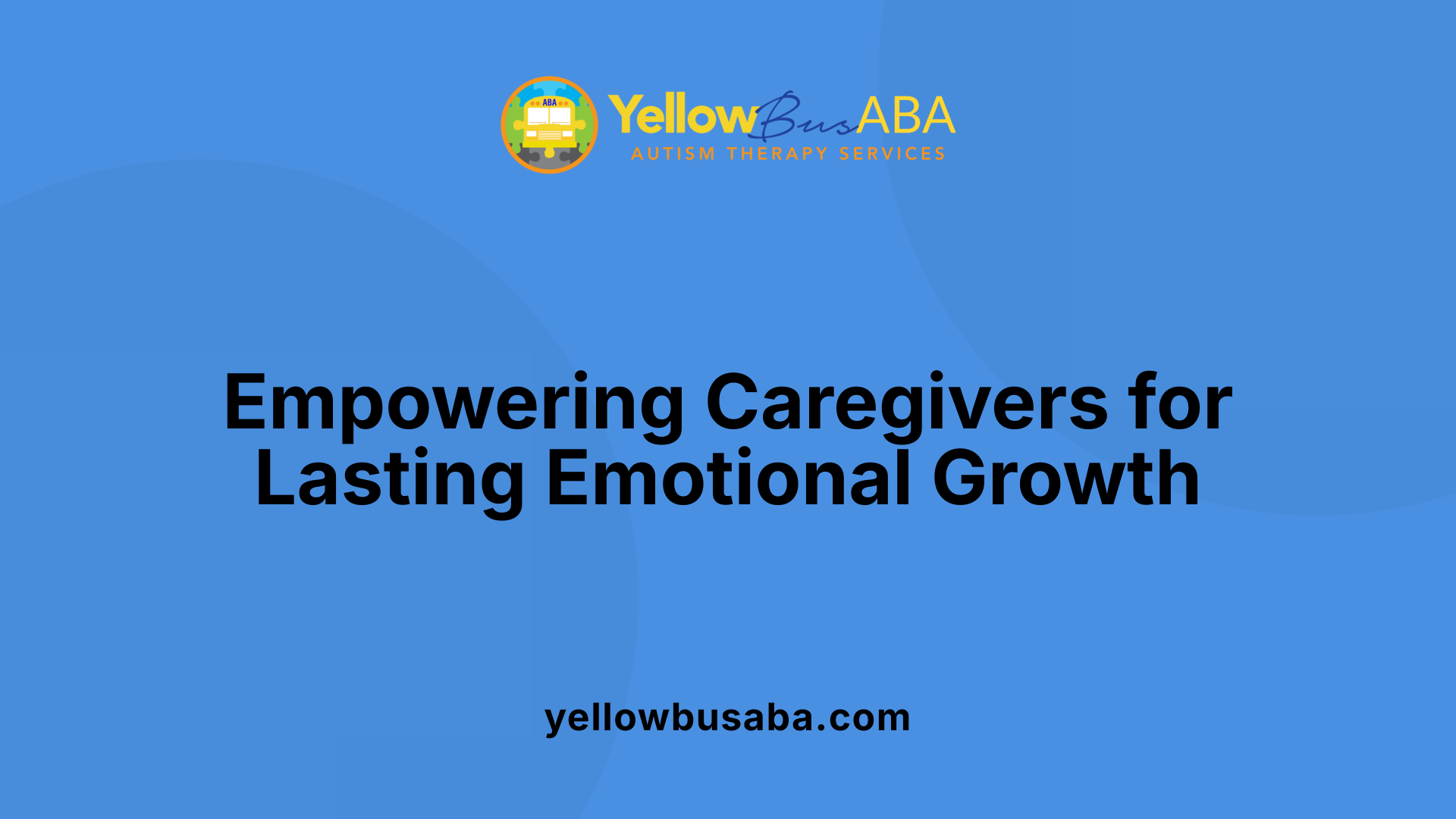Understanding ABA’s Impact on Emotional Growth
Applied Behavior Analysis (ABA) has become a cornerstone in supporting emotional regulation among individuals with developmental disabilities and autism. By combining structured, reward-based techniques with a thorough understanding of behavioral science, ABA fosters emotional awareness, resilience, and social competence. This article explores how ABA therapy contributes to emotional development, its methodologies, research findings, and practical applications in various settings, emphasizing its vital role in enhancing emotional regulation skills.
Foundations of ABA in Emotional Regulation

What are the basic principles of ABA?
Applied Behavior Analysis (ABA) is grounded in the scientific understanding of how behavior functions and is maintained. It emphasizes breaking down complex skills into small, manageable steps and teaching these systematically using evidence-based procedures. ABA focuses on understanding individual behaviors within their context to develop targeted interventions that promote positive changes.
How is reward-based learning used in ABA?
Reward-based learning is a core component of ABA therapy. Therapists use positive reinforcement to motivate children and adults to acquire new skills and reduce undesirable behaviors. When a person performs a desired behavior, they receive a carefully chosen reward, which increases the likelihood of the behavior recurring. This approach helps build communication, social, and daily living skills effectively.
What is involved in the initial assessment and plan development?
Initially, an ABA therapist evaluates the individual's behavior, abilities, and needs through observations and standardized tools like the Vineland-3 assessment. This evaluation helps identify strengths and areas for improvement. Based on these findings, a personalized treatment plan is created, with specific, measurable goals. The plan focuses on teaching skills incrementally and setting routines that support emotional regulation.
How does ABA support emotional regulation?
ABA therapy supports emotional regulation by teaching individuals how to recognize and manage their feelings through structured techniques. Visual aids, social stories, role-playing, and reinforcement strategies help individuals understand their emotions and develop coping skills. For example, they might learn to request a break or practice deep breathing when overwhelmed.
The role of caregiver involvement
Caregivers and family members are actively trained to reinforce skills learned during therapy sessions at home and in daily life. This consistency across environments helps sustain progress and generalize emotional regulation strategies outside of clinical settings.
| Concept | Description | Example Activities |
|---|---|---|
| Basic Principles | Scientific approach focusing on behavior modification | Skill breakdown, data collection |
| Reward-Based Learning | Use of positive reinforcement to promote behavior | Praise, tokens, preferred activities |
| Initial Assessment | Customized evaluation to establish baseline and goals | Observations, standardized assessments |
| Emotional Regulation Skills | Techniques to recognize and manage emotions effectively | Visual aids, social stories, coping strategies |
This structured foundation enables individuals to build resilience, develop social skills, and improve overall functioning, profoundly impacting their everyday life.
Techniques and Strategies for Emotional Regulation in ABA

What techniques and strategies are used in ABA therapy to improve emotional regulation?
ABA therapy employs a variety of evidence-based methods to help individuals manage their emotions effectively. Central to these strategies are positive reinforcement and modeling. Therapists reward desired behaviors, encouraging children to repeat appropriate emotional responses and social interactions.
Modeling and role-playing are also crucial. Through demonstration and practice, children learn how to react flexibly to different emotional situations. Visual supports, such as emotion cards and social stories, serve as visual reminders to recognize, understand, and label feelings. The Zones of Regulation curriculum further supports this by teaching skills to categorize emotions into zones, promoting self-awareness.
Relaxation and coping techniques are integrated into therapy plans. These include deep breathing exercises, sensory breaks, and other calming strategies designed to help individuals regulate their emotions during distressing moments.
A comprehensive assessment called Functional Behavior Assessment (FBA) is used to identify specific triggers that lead to problem behaviors. This informs personalized intervention plans tailored to each child's unique needs.
Visual supports and social stories are effective tools that aid in understanding emotional cues and practicing appropriate responses. These methods create a predictable framework that helps children and individuals learn to navigate challenging emotional situations.
Consistency in applying these techniques across different environments is vital. Caregivers and families are trained to reinforce strategies outside therapy sessions, ensuring skills are generalized and maintained over time.
By combining these approaches—positive reinforcement, modeling, visual aids, relaxation strategies, and thorough assessments—ABA therapy offers a structured pathway to improve emotional regulation, leading to better social interactions and overall well-being.
Efficacy of ABA in Supporting Emotional Development

What does research say about the impact of ABA therapy on emotional regulation skills?
Research indicates that ABA therapy can effectively enhance emotional regulation skills, particularly in children with autism. Studies have documented significant strides in managing emotional responses, including a reduction in emotional instability and negative behaviors.
While traditionally recognized for improving behavioral functions and communication skills, recent research has highlighted how ABA's structured and reward-based approach fosters better emotion management. This is often achieved through tailored interventions that incorporate emotional regulation goals alongside behavioral objectives.
Additionally, combining ABA with other therapeutic approaches like DIR/floor time play therapy can further boost social skills and emotional understanding. DIR/floor time emphasizes relationship-building and emotional exploration, which complements ABA's focus on observable behaviors.
Follow-up assessments over time suggest these improvements are long-lasting. Children benefiting from ABA not only learn to control their emotions better but also demonstrate improved social interactions and decreased problematic behaviors.
Overall, scientific evidence supports ABA as a robust method for promoting emotional regulation in children with autism, helping them navigate their feelings more effectively within daily life contexts.
Application of ABA in Educational and Therapeutic Contexts

How is ABA therapy applied in educational and therapeutic settings to support emotional regulation?
ABA therapy employs tailored, research-based approaches aimed at helping individuals manage their emotions effectively. In classrooms and therapy spaces, these interventions focus on teaching and reinforcing skills that contribute to emotional stability.
In schools, professionals often use techniques such as Discrete Trial Training (DTT) and natural environment teaching to facilitate learning. These methods involve breaking down complex skills into small, manageable steps and providing immediate positive reinforcement when goals are achieved. For example, a student might learn to recognize and name different emotions using visual aids and then practice appropriate responses in real-life situations.
Therapists and educators collaboratively develop behavior intervention plans based on functional behavior assessments (FBAs) which identify triggers and effective strategies for each individual. These plans are integrated into daily routines, ensuring consistency across therapy, classroom, and home environments.
Family and caregiver involvement is crucial. Training parents and staff on consistent reinforcement techniques helps sustain progress. Through this collaborative effort, children are supported in developing emotional regulation skills, reducing problematic behaviors, and improving their social and communication abilities.
Overall, ABA’s precise, goal-oriented methods enable individuals to better understand and control their emotions, fostering success both academically and socially.
What techniques are used in classroom and therapy settings to promote emotional regulation?
Common ABA techniques include Discrete Trial Training (DTT), pivotal response treatment, and natural environment teaching. These are designed to teach specific skills step-by-step.
Positive reinforcement is a central element, encouraging desired behaviors through rewards such as praise, tokens, or preferred activities.
In addition to skill development, visual supports like emotion charts and social stories help individuals identify feelings and appropriate coping strategies.
Specialized curricula, like The Zones of Regulation®, offer language and tools to help children recognize their emotional states and navigate social contexts effectively.
These techniques are tailored to each child's needs, ensuring they are engaging and effective.
How do collaboration efforts with families and teachers enhance ABA's effectiveness?
Collaboration is essential for consistent progress. ABA therapists work closely with families and teachers to design and implement intervention plans.
Training caregivers on reinforcement and behavior management strategies ensures that skills learned in therapy are practiced across settings.
Regular communication allows for adjustments based on progress and challenges faced at home and school.
This teamwork leads to more meaningful, durable changes in behavior and emotional regulation.
What are the goals of ABA regarding skill development?
The primary aims include improving communication, reducing dangerous or disruptive behaviors, and teaching age-appropriate social skills.
By focusing on these areas, ABA supports individuals in becoming more independent and socially integrated.
Efforts often lead to measurable improvements, such as increased communication abilities and decreased aggression or self-injury.
| Strategy | Setting | Focus | Outcome |
|---|---|---|---|
| Discrete Trial Training | Clinic, School | Skill acquisition | Learning new behaviors or skills |
| Natural Environment Teaching | Classroom, Home | Generalization of skills | Applying skills in real-world situations |
| Pivotal Response Treatment | Therapy | Motivation and pivotal skills | Broader development improvements |
| Visual Supports & Social Stories | Classroom | Emotional recognition & regulation | Better understanding of emotions |
Research shows that these techniques support meaningful gains, helping individuals regulate emotions and participate fully in everyday life.
Search Query for Further Information
ABA strategies in schools and clinics for emotional regulation
The Role of Caregiver Involvement and Skill Generalization

How does ABA therapy contribute to emotional development in individuals with developmental disabilities or autism?
ABA therapy plays a significant role in promoting emotional growth alongside behavioral and social skills. It teaches individuals to recognize, understand, and label their own emotions, as well as those expressed by others. This is achieved through various techniques such as modeling appropriate responses, using visual supports, and engaging in exercises focused on emotion recognition.
By fostering better emotional awareness and regulation, ABA helps individuals manage their feelings more effectively. It encourages the expression of socially appropriate responses, which enhances social interactions and promotes empathy. These strategies are tailored to each person's needs, ensuring respect for neurodiversity and personal differences.
Ultimately, ABA supports meaningful development of emotional skills by combining positive reinforcement with personalized approaches. This holistic focus not only improves emotional understanding but also contributes to increased social participation and independence in everyday life.
How does ABA therapy contribute to emotional development in individuals with developmental disabilities or autism?
| Aspect of Emotional Development | Techniques Used in ABA | Expected Outcomes | Additional Details |
|---|---|---|---|
| Recognition of emotions | Modeling, visual supports | Better identification of own and others' feelings | Enhances social awareness |
| Emotional regulation | Skill-building exercises | Managing and responding appropriately to emotions | Respects individual differences |
| Social-emotional responses | Positive reinforcement | Increased appropriate social behaviors | Supports empathy and social integration |
Caregiver training is crucial to extend these skills beyond clinical sessions. Families learn strategies to reinforce emotional understanding at home, in school, and in community settings. This consistent support allows for the generalization of skills, fostering emotional resilience and adaptive social behaviors across various environments.
Research emphasizes that caregiver involvement amplifies the effectiveness of ABA. When families are equipped with knowledge and tools, children show faster progress, reaching communication and social goals more efficiently. They often achieve significant milestones, such as reaching 75% of communication goals within six months of therapy.
Services are provided in diverse settings—including clinics, in-home, telehealth, and schools—ensuring accessibility and fitting individual needs. Utilizing tools like the Vineland-3 assessment helps measure progress across communication, socialization, and daily living skills, ensuring that therapy remains targeted and effective.
Complementary Approaches and Future Directions
How do behavioral and talk therapies compare?
Behavioral therapies like ABA focus on changing observable behaviors using reward-based learning methods. They are highly structured and emphasize skill acquisition and reduction of problematic behaviors. In contrast, talk therapies such as Dialectical Behavior Therapy (DBT) are more geared toward understanding and regulating emotions through conversation and skills training. DBT emphasizes validation and building emotional resilience, making it especially effective for conditions involving intense emotional experiences like borderline personality disorder, PTSD, or self-harm.
While ABA primarily concentrates on skill development to improve communication, social, and daily living skills, talk therapies aim to foster emotional understanding and regulation. Both approaches can be integrated to address complex needs, with behavioral techniques teaching coping tools within a supportive emotional framework.
What is The Zones of Regulation curriculum?
The Zones of Regulation® is an educational program designed to help individuals build self-awareness about their emotions and develop social-emotional skills. Designed for children and used worldwide for over 15 years, it creates a common language for identifying feelings, solving problems, and managing emotions.
The curriculum includes a variety of resources, such as digital tools, storybooks, and visual aids like posters and tools to try cards. An essential aspect of the program is fostering a positive environment where students learn to recognize their emotional states—represented by different 'zones'—and employ strategies to navigate these states effectively.
Interactive activities, like The Navigating the Zones Game, help extend learning beyond the classroom, making emotional regulation skills accessible and engaging.
How does the combination of therapies impact outcomes?
Combining ABA with social-emotional curricula like The Zones of Regulation enhances overall treatment effectiveness. ABA's focus on skill-building complements emotional understanding and regulation strategies, leading to more holistic growth for children with developmental disorders.
For example, ABA can teach social skills and reduce problem behaviors, while Zones resources help children recognize their feelings and respond appropriately. This integrated approach promotes better social interactions, emotional resilience, and adaptive functioning across various environments, including home, school, and community.
What advancements are being made in research?
Recent research highlights that ABA therapy significantly improves neural development related to sensory, motor, cognitive, and social-emotional functions. Evidence-based ABA interventions tailored to individual needs are showing promising outcomes, such as reaching 75% of communication goals within six months at clinics like Cortica.
Additionally, ongoing studies explore how combining ABA with emotional regulation curricula impacts long-term behavior and mental health outcomes. New tools like the Vineland-3 assessment measure progress across communication, socialization, and daily skills, helping refine treatment plans.
Research continues to evolve, focusing on personalized approaches and integrating multiple therapies to support comprehensive emotional and behavioral development.
| Approach | Focus Area | Typical Duration | Common Tools | Notable Outcomes |
|---|---|---|---|---|
| ABA | Behavior, communication, social skills | Several months to years | Rewards, visual aids, social stories | Skill mastery, behavior reduction, communication improvements |
| DBT | Emotion regulation, distress tolerance | 6 months to several years | Mindfulness, interpersonal effectiveness | Reductions in self-harm, anger, hospitalizations |
| Zones of Regulation | Self-awareness, emotional management | Ongoing, adapted to individual needs | Posters, storybooks, game activities | Improved emotional recognition, problem-solving skills |
These evolving therapies and curricula aim to provide flexible, personalized support for individuals’ developmental needs.
Conclusion and Future Perspectives
How has ABA therapy impacted personal development and societal integration?
ABA therapy has profoundly influenced how children with developmental challenges, especially autism spectrum disorder, develop crucial behavioral, communication, and social skills. Through reward-based learning, children learn to engage more effectively with their environment, leading to notable improvements in communication and daily functioning. For example, clients at Cortica have demonstrated significant progress, achieving 75% of communication goals within six months.
By targeting specific behaviors and breaking down skills into manageable steps, ABA fosters neural growth across sensory, motor, cognitive, and social-emotional domains. Its versatility extends beyond autism, offering strategies to address conditions such as ADHD, OCD, and PTSD by promoting positive behaviors amidst distressing circumstances.
Why is ongoing research crucial for ABA and emotional support?
Despite its successes, there is a continuous need for research to refine ABA techniques and expand their applications. Innovations in assessment tools like the Vineland-3 assist clinicians in tracking progress comprehensively across communication, socialization, and daily living skills.
Current research aims to improve personalized treatment plans, optimize intervention timing, and enhance the generalization of skills in varied environments. This ongoing work ensures that ABA remains a dynamic, evidence-based approach capable of meeting evolving developmental and emotional needs.
How can ABA be integrated with broader emotional well-being programs?
Effective emotional regulation is critical for overall mental health. Integrating ABA with programs like The Zones of Regulation® offers a combined framework to deepen emotional understanding and management. The curriculum uses visual resources, storybooks, and interactive games to foster self-awareness and social skills.
Combining behavioral techniques with emotional regulation curricula creates a comprehensive support system that addresses both external behaviors and internal emotional states. This integration helps individuals build resilience and develop adaptive coping strategies, which are vital for long-term well-being and societal participation.
| Aspect | Focus Area | Description |
|---|---|---|
| Impact of ABA | Developmental progress | Enhances communication, social skills, and reduces dangerous behaviors |
| Research Needs | Continued innovation | Improves assessment tools, personalization, and skill generalization |
| Emotional Support Integration | Holistic emotional health | Combines ABA with emotional regulation programs for comprehensive support |
By fostering ongoing innovation and integrating emotional support strategies, ABA is poised to continue making meaningful contributions to individual growth and societal inclusion.
Charting the Path Forward in Emotional Support
The integration of ABA therapy into emotional development strategies represents a significant advancement in supporting individuals with developmental disabilities and autism. Its personalized, data-driven approach not only facilitates immediate behavioral improvements but also fosters enduring skills in emotional regulation. As research continues to evolve, the future of ABA includes deeper integration with complementary therapies like Dialectical Behavior Therapy, social-emotional curricula such as Zones of Regulation, and innovative technology-driven interventions. Emphasizing caregiver involvement, skill generalization, and holistic support systems will be essential in maximizing outcomes. Ultimately, ongoing commitment to research, adaptation, and comprehensive care will ensure that individuals develop the resilience and emotional intelligence necessary for thriving in diverse social environments.
References
- Applied Behavioral Analysis (ABA) Therapists in Lakeville, MN
- Dialectical Behavior Therapy (DBT): What It Is & Purpose
- Applied Behavioral Analysis (ABA) Therapists in West Melbourne, FL
- Cortica | Whole-Child Autism Care Centers
- Resources - The Zones of Regulation
- [PDF] Emotional Regulation Strategies
- Practical Strategies to Teach Emotional Regulation Skills in ABA ...
- From Meltdowns to Calm:ABA Therapy Strategies for Managing ...
- Simple Evidence-based Strategies for Teaching Emotion Regulation






